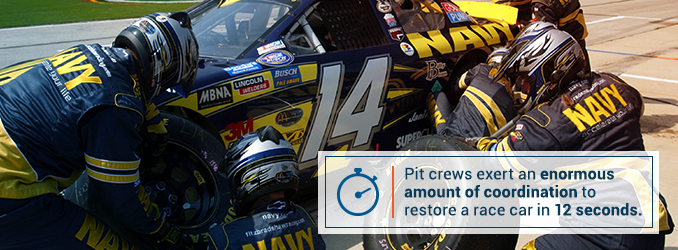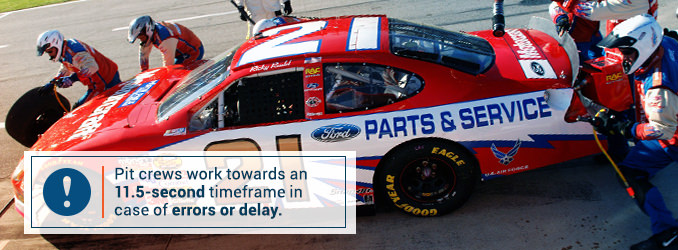Chapter 3: Anatomy of the 12-Second Pit Stop
Evolving over six decades, NASCAR’s pit crews are now operating at peak efficiency and to the point where the routine is more like an art form. Restoring a race car to a competitive state in under 12 seconds takes an enormous amount of coordination, and it all begins before the driver has even left the oval.

Operational Procedure
Drivers are usually in constant communication with their car chief — allowing them to form new plans of action should a problem arise. It doesn’t matter if it’s the 4th of the 400th lap, if an irregularity occurs or if conditions on the track suddenly take a turn for the worse, you can bet the driver will pull in to pit road.
Once they do, it’s up to the support staff and crew to ensure that everything is completed or addressed as quickly as possible. Unless major work is required to be performed back at the garage, the car chief sets the 12-second countdown.
Competitive Milestones
Breaking it down, the modern pit stop can be categorized into five separate sections. Missing a single milestone by a fraction of a second can lead to an over-costed service and a significant reshuffling of driver positions.
Here’s what pit crews are doing every time they go over the wall:
 |
0.5 Seconds — As the car comes off the oval and moves towards the pit box, the crew — waiting in the wings and equipped with pit crew gear like air compressors, spare tires and pneumatic tools — springs into action, hopping over the wall when the car rolls to a stop. Moving into position is a well-timed affair and one that is most crucial at this early stage. The success of subsequent maneuvers and indeed, the entire service, depends on each mechanic getting to their post in good time. |
|
|
|
 |
2 Seconds — The jackman, bringing a hydraulic floor jack, leverages the far side of the car to provide the tire carriers with access to the front and rear right wheels. The gas man, wearing a fire suit, will dump both sticks of the two, 12-gallon fuel cans into the vehicle’s intake. |
|
|
|
 |
5 Seconds — Once the far side of the vehicle is lifted, the two tire changers use air guns and impact wrenches to remove each wheel’s five lug nuts — cranking them at speeds that are too quick to be captured by the human eye. |
|
|
|
 |
7 Seconds — As each right-hand wheel comes free, the tire carriers slide the new tires into place and exchange the old ones at the wall. They each then carry a new tire for the left side of the vehicle where the tire changers will be ready. |
|
|
|
 |
12 Seconds — Assuming no mistakes have been made, the home stretch involves a repeat of previous events on the left side. The jackman lowers the car and moves to the other side in order to assist the carriers. |
As the last tire locks into place, the gas man finishes refueling the car’s tanks and signals to the crew that the job is done. The jackman then drops the vehicle to the ground as the driver drops the clutch, shifts into gear and drives off to continue the race.
While mistakes are rare, pit crews work towards achieving a target time of 11.5 seconds to allow for anything that may cause or create a slight delay. As long as any errors occur within this small margin of error, the pit stop is considered a total success.
Now that the technical sequence of the pit crew is out of the way, it seems appropriate to evaluate the impact that pit crews have had — and are still having — upon the popular motorsport.
Table of Contents
- The Tools of a NASCAR Pit Crew
- Introduction
- Chapter 1: A Brief History of Pit Crew Racing
- Chapter 2: Structure of Race Car Pit Crews
- Chapter 3: Anatomy of the 12-Second Pit Stop
- Chapter 4: The Sports Science Behind NASCAR
- Chapter 5: Evolution of Tools and Racing Equipment
- Chapter 6: Factors Affecting Podium Positions
- Chapter 7: The Future of Pit Crews
- Conclusion: NASCAR as a National Phenomenon


